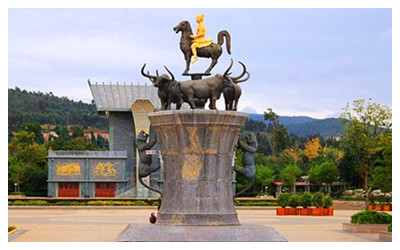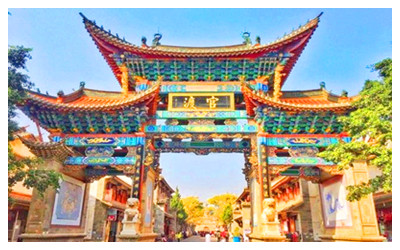Skype: neodalle-travel
Tel: +86 135 7447 2266
E-mail: sales@zhangjiajieholiday.com

 The Ancient Dian Culture refers to that created by the Dian tribe during the years from the Spring and Autumn Period (770-475 B.C) through the Warring States Period (476-221 B.C) to the mid Eastern Han Dynasty (25 B.C-220 A.D). In 279 B.C, King Qingxiang of Chu State dispatched his general Zhuang Jue to Dianchi Lake in Yunnan for a pioneering mission, and with his forces Zhuang claimed this land for the Chu State; however, later on their way back home they were cut off by the troops of the Qin State which destroyed the Chu State; Zhuang and his more than 20,000 soldiers were obliged to settle down, and "did in Rome as Romans did"; then Zhuang set up the Dian Kingdom, a slavery state, and proclaimed himself king. Zhuang's descendant Changqiang sent his officials to help the envoys of Emperor Wudi (156-87 B.C) in the Western Han Dynasty (206 B.C-24 A.D) to explore the "Shu-Yuan-Du Road" -the Southern Silk Road (Shu refers to Sichuan, Yuan refers to Yunnan and Du refers to Ancient India). After Changqiang surrendered him and his army to the Han Dynasty, he was appointed by Emperor Wudi as the king of Dian Kingdom and granted a golden seal.
The Ancient Dian Culture refers to that created by the Dian tribe during the years from the Spring and Autumn Period (770-475 B.C) through the Warring States Period (476-221 B.C) to the mid Eastern Han Dynasty (25 B.C-220 A.D). In 279 B.C, King Qingxiang of Chu State dispatched his general Zhuang Jue to Dianchi Lake in Yunnan for a pioneering mission, and with his forces Zhuang claimed this land for the Chu State; however, later on their way back home they were cut off by the troops of the Qin State which destroyed the Chu State; Zhuang and his more than 20,000 soldiers were obliged to settle down, and "did in Rome as Romans did"; then Zhuang set up the Dian Kingdom, a slavery state, and proclaimed himself king. Zhuang's descendant Changqiang sent his officials to help the envoys of Emperor Wudi (156-87 B.C) in the Western Han Dynasty (206 B.C-24 A.D) to explore the "Shu-Yuan-Du Road" -the Southern Silk Road (Shu refers to Sichuan, Yuan refers to Yunnan and Du refers to Ancient India). After Changqiang surrendered him and his army to the Han Dynasty, he was appointed by Emperor Wudi as the king of Dian Kingdom and granted a golden seal. Guandu Ancient Town is home the Ancient Dain Culture. In fact, the economy and culture in the Dianchi area were already much developed long before Zhuang Jue came to Yunnan; according to Records of the Historian, "By the 300-li Dianchi Lake lies a vast fertile flatland stretching for thousands of li "where the indigenous people" live in communes and practice farming". After Zhuang settled down in Yunnan, his men married native women and a brilliant bronze culture of the Ancient Dian thus grew out of the Chu Culture and the local ethnic cultures in Southwest China.
Guandu Ancient Town is home the Ancient Dain Culture. In fact, the economy and culture in the Dianchi area were already much developed long before Zhuang Jue came to Yunnan; according to Records of the Historian, "By the 300-li Dianchi Lake lies a vast fertile flatland stretching for thousands of li "where the indigenous people" live in communes and practice farming". After Zhuang settled down in Yunnan, his men married native women and a brilliant bronze culture of the Ancient Dian thus grew out of the Chu Culture and the local ethnic cultures in Southwest China.
Yet the records about the Ancient Dian Kingdom are far from complete though some are found in Records of the Historian(<
Both historical records and archaeological finds have revealed that the Ancient Dian Kingdom existed roughly between the Warring States Period and the mid Eastern Han Dynasty. With the present Jincheng Township of Jinning County as its capital, the kingdom extended to Qujing and Luxi in the east, to Lufeng and An'ning in the west, to Zhaotong in the north and to Xinping, Yuanjiang and Gejiu in the south; with the Dian being its majority, the kingdom included such nationalities as the Kunming, the Sou, and the Han. Further, this area had the most advanced economic production in Yunnan at that time, and based on farming, it had also developed husbandry, fishery and hunting; it was also fairly advanced in such industries as mining, textile and pottery.
When talking about the Ancient Dian Culture, we refer to two historical periods, namely the first lasting from the Spring and Autumn Period to the late Warring States Period and the second from the late Warring States Period to the mid Eastern Han Dynasty. Since the Ancient Dian Kingdom did not yet develop a language of its own, its own culture and those before it were all represented by the Bronze Culture.
The Bronze Culture during the first period is symbolized by the bronze drum unearthed in the Wanjia Flatland of the Chuxiong Yi Autonomous Prefecture and the bronze coffin unearthed in Dabona of Xiangyun County. The bronze drum, made more than 600 years before Christ (i.e. in the Spring and Autumn Period) is a plain traditional vessel between cauldron and drum generally acknowledged to be the oldest of its kind in the world; weighing 257 kg, the bonze coffin excavated at Dabona is the largest bronze ware in Yunnan.
The period from the Warring States Period to the Han Dynasty marked the culmination of the bronze culture in Yunnan, of which the bronze objects unearthed both at the Shizhai Mountain of Jinning and the Lijia Mountain of Jiangchuan are the most typical; these bronze wares include such objects as military weapons, farming tools, post-railing house models, bronze pillars, and bronze reed pipes. Among the objects unearthed at Shizhai Mountain, the most valuable are shell containers in the form of drum and barrel; as many as 17 bronze drums were unearthed at this mountain, the largest number of bronze drums ever unearthed at a single site in China. The varied patterns cast on the surface of the vessels represent such social events as production, sacrifice offering, battle and tribute paying, and thus most vividly reveal social features of the slavery system in the Ancient Dian Kingdom; the lid of a vessel is as small as 20 to 30 cm in diameter, but cast on it were more than 100 human figures, and all vividly characterized; in a scene of homicidal sacrifice, for instance, as many as 127 human figures were facing east. In some battle fighting scenes, the pig-tailed Kunmingese were usually shown in defeat, captured, and beheaded by the bun-haired Dians. Their hairstyles are represented exactly as recorded in Records of the Historian by Sima Qian. Among the bronze wares unearthed at the Lijia Mountain, the most priceless is the "Cow and Tiger Bronze Table"; it is the best quality product in the bronze realm of the Ancient Dian Culture. Also it is noteworthy that the high quality of the bronze ware excavated at the Shizhai and Lijia mountains had much to do with the then popular "lost-wax" casting technique; the ratio of copper and tin in the bronze ware was scientific.
To sum up, the highly advanced Ancient Dian Culture fostered the area around Dianchi Lake into an early political, economic and cultural center of Yunnan, thus exerting its influence to the vast minority area in Southwest China and developing the society, economy and culture of this area.
 Ask Questions ?
Ask Questions ?